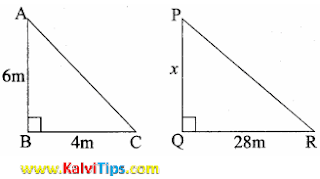Tamil Nadu Board 10th Standard Maths - Chapter 4 Unit Exercise 4.1: Book Back Answers and Solutions
This post covers the book back answers and solutions for Chapter 4 Unit Exercise 4.1 – Maths from the Tamil Nadu State Board 10th Standard textbook. These detailed answers have been carefully prepared by our expert teachers at KalviTips.com.
We have explained each answer in a simple, easy-to-understand format, highlighting important points step by step under the relevant subtopics. Students are advised to read and memorize these subtopics thoroughly. Once you understand the main concepts, you’ll be able to connect other related points with real-life examples and confidently present them in your tests and exams.
By going through this material, you’ll gain a strong understanding of Chapter 4 Unit Exercise 4.1 along with the corresponding book back questions and answers (PDF format).
Question Types Covered:
- 1 Mark Questions: Choose the correct answer, Fill in the blanks, Identify the correct statement, Match the following
- 2 Mark Questions: Answer briefly
- 3, 4, and 5 Mark Questions: Answer in detail
All answers are presented in a clear and student-friendly manner, focusing on key points to help you score full marks.
All the best, Class 10 students! Prepare well and aim for top scores. Thank you!
Chapter 4 Algebra Unit Ex 4.1
∴ The two triangles are not similar.
∠PQC = 70°
∠ABC = ∠PQC = 70°
∠ACB = ∠PCQ (common)
∆ABC ~ ∆PQC
6x = 15
∴ x = 2.5
Answer Key:
Let the height of the tower ED be “x” m. In ∆ABC and ∆EDC.
∠ABC = ∠CED = 90° (vertical Pole)
∠ACB = ∠ECD (Laws of reflection)
∆ ABC ~ ∆DEC

= 1.5 × 219 = 328.5
The height of the Lamp Post = 328.5 m
Answer Key:
∠ABC = ∠PQR = 90° (Vertical Stick)
∠ACB = ∠PRQ (Same time casts shadow)
∆BCA ~ ∆QRP

4x = 6 × 28 ⇒ x = = 42
Length of the lamp post = 42m
Answer Key:
In ∆PQT and ∆STR we have
∠P = ∠S = 90° (Given)
∠PTQ = ∠STR (Vertically opposite angle)

Hence it is proved.

∠ACB = ∠AED = 90°
∠A = ∠A (common)
∴ ∆ABC ~ ∆ADE (By AA similarity)
= 122 + 52 = 144 + 25 = 169
AB = 169 = 13
Consider,
∴ AE =
AE = and DE =
Consider,
DE =

4 AC = 8 × 2.8
AC = = 5.6 cm
Consider
8 AQ = 4 × 6.5
AQ = = 3.25 cm
Length of AC = 5.6 cm; Length of AQ = 3.25 cm

(ii) ∆LOP ~ ∆RPN
(iii) ∆QMO ~ ∆RPN
(iv) QR2 = MQ × RN.
Answer Key:
(i) In ∆LOP and ∆QMO
∠OLP = ∠OQM = 90°
∠LOP = ∠OMQ (Since OQRP is a square OP || MN)
∴ ∆LOP~ ∆QMO (By AA similarity)
∠OLP = ∠PRN = 90°
∠LPO = ∠PNR (OP || MN) .
∴ ∆LOP ~ ∆RPN (By AA similarity)
∠MQO = ∠NRP = 90°
∠RPN = ∠QOM (OP || MN)
∴ ∆QMO ~ ∆RPN (By AA similarity)
QR2 = MQ × RN
Hence it is proved.
Answer Key:
()2 = ()2
EF = = 2.8 cm
Legth of EF = 2.8 cm

In the ∆PAC and ∆BQC
∠PAC = ∠QBC = 90°
∠C is common
∆PAC ~ QBC
In the ∆ACR and ∆QBC
∠ACR = ∠QBC = 90°
∠A is common
∆ACR ~ ABQ
By adding (1) and (2)
9y = 18 ⇒ y = = 2
The Value of y = 2m
Answer Key:
Given ∆PQR, we are required to construct another triangle whose sides are of the corresponding sides of the ∆PQR

(ii) Draw a ray QX making an acute angle with QR on the side opposite to the vertex P.
(iii) Locate 3 points Q1, Q2 and Q3 on QX.
So that QQ1 = Q1Q2 = Q2Q3
(iv) Join Q3 R and draw a line through Q2 parallel to Q3 R to intersect QR at R’.
(v) Draw a line through R’ parallel to the line RP to intersect QP at P’. Then ∆ P’QR’ is the required triangle.
Answer Key:
- Construct a ∆LMN with any measurement.
- Draw a ray MX making an acute angle with MN on the side opposite to the vertex L.
- Locate
5 Points Q1, Q2, Q3, Q4, Q5
on MX.
So that MQ1 = Q1Q2 = Q2Q3 = Q3Q4 = Q4Q5 - Join Q5 N and draw a line through Q4. Parallel to Q5N to intersect MN at N’.
- Draw a line through N’ parallel to the line LN to intersect ML at L’.
Answer Key:
Steps of construction
(i) Construct an ∆ABC with any measurement.
(ii) Draw a ray BX making an acute angle with BC.
(iii) Locate 6 points Q1, Q2, Q3, Q4, Q5, Q6 on BX such that
BQ1 = Q1Q2 = Q2Q3 = Q3Q4 = Q5Q6

(v) Draw a line through C’ parallel to AC intersecting the extended line segment AB at A’.
∆A’BC’ is the required triangle.
Answer Key:
(ii) Draw a ray QX making an acute angle with QR on the side opposite to the vertex P.
(iii) Locate 7 points Q1, Q2, Q3, Q4, Q5, Q6, Q7 on QX.
So that
QQ1 = Q1Q2 = Q2Q3 = Q3Q4 = Q5Q6 = Q6Q7

Intersecting the extended line segment QP at P’.
∴ ∆P’QR’ is the required triangle.










0 Comments:
Post a Comment